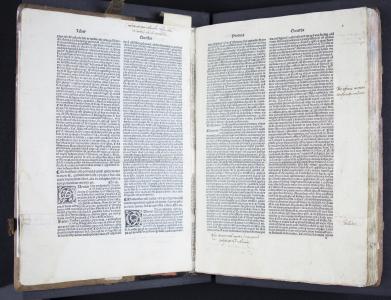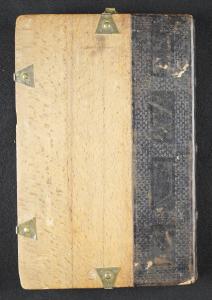

The works in this exhibit are all later versions or publications of titles, authors, or documents that are represented in the Rouse Medieval Manuscript collection. The exhibit content was created by students in a History of the Book seminar in Winter 2014 in the Information Studies Department at UCLA.
Exhibit Home
1. An exact collection of all remonstrances,...
3. Divi Avrelii Avgvstini Hippon. Episcopi...
4. Horae in laudem beatiss[ima] Virginis secu[n]dum....
5. Hore in laudem beatissime Virg[inis] Marie...
6. Les memoires, contenans le discours de plusieurs...
7. Modus Bene Viuendi (Modus Bene Vivendi)
8. Psalteriu[m] v[ir]ginis sanctissime [secundum]...
9. Q. Asco. Pediani In Ciceronis orationes...
10. Quaestiones super XII libros Metaphysicae...
11. Stimulus diuini amoris Sancti Bonauenturae
12. Varii sermoni de Santo Agostino...
13. Varii sermoni di Santo Agostino
Title Quaestiones super XII libros Metaphysicae



Brief description
Physical description
Content description This volume is also bound with five additional books listed below in the order of the book: Trombetta, Antonio. Opus doctrine Scotice Patauii in thomistas discussum Sententiis phylosophi maxi[m]e co[n]ueniensus. Published in Venice, Italy by Girolamo de’ Paganini. 15 Nov 1493. Voyager ID: 3316538 Biondo, Flavio. Roma instaurata. De origine et gestis Venetorum. Italia illustrata. Published in Verona, Italy by Boninus de Boninis, 1481-1482. Call #: *A1 .B622r 1481; Voyager ID: 730641 Euclid. ELEMENTA GEOMETRIA. Published in Vicenza, Italy by, Leonhard Achates & Guglielmo de Pavia. 1491. Siculus, Diodorus. BIBLIOTHECAE HISTORICAE LIBRE VI. Published in Venice, Italy by Giovanni Tacuino. 1496. Paulus Orosius. HISTORIAE ADVERSUS PAGANOS. Published in Venice, Italy by Bernardino Bindoni. 1500. There was no colophon in any section of the volume. Inside the front wooden cover were two bookplates. The first reads “Livre No 64 de la Biblioteque Pillone Pierre Beres” and the second reads “Thomas Brooke F.S.A. Armitage Bridge.” The Pillone Family Library began during the Renaissance and grew throughout the sixteenth century. The library survived well into the nineteenth century until it was sold to Paolo Maresio Bazolle in 1874[1]. Sir Thomas Brooke, a British antiquarian and book collector, bought only the books featuring fore-edge paintings by Vecellio. This volume was included in that purchase. The collection was eventually sold to Pierre Berès, a Parisian dealer, who eventually sold the books at auction where they were dispersed[2]. The six books have been bound together using recycled paper pages that do have printing on them. The volumes are printed on paper and bound in between wood covers with leather embellishment which covers the spine and two inches of the wood coverings. The volume would have been closed with four leather clasps, of which all but one have now eroded away. The size of the volume is 8.5” x 13-3/16” x 1 5/8” on the outside. The pages themselves are quarto sized. The paper has a watermark imprinted into it on several of the pages. The watermark looks like a circular vessel with two teardrop shapes inside it. There is a star coming out of the top of the vessel. On some of the pages there are water spots and indications of mold spots that may have been lightly cleaned up. The printing in each of the books in this volume is double-sided and was likely printed using a printing press as these were all published decades after the invention of the Gutenberg press. Two pages in the volume have red ink print which indicates a second pass through the printing press for those two books: Bibliothecae Historicae Libre VI and Historiae Adversus Paganos. According to the history enclosed with the book, the fore-edges were painted by Cesare Vecellio who was a nephew of Titian. While it is obvious that the edges were painted only a trace of red and black forms remains on the edges and there is no hint of what image had been painted. There is a significant amount of writing in the margins throughout the entire volume. This volume seems to have been well-used. Quaestiones super XII libros Metaphysicae Aristotelis which translates to “Questions on 12 books of the Metaphysics of Aristotle” was first printed in 1481. There is not much information about when the book was originally written. The author, Antonius Andreae, was a Spanish Franciscan scholar who lived from approximately 1280—1320 and was a disciple of the philosopher Duns Scotus.[3] Duns Scotus was a philosopher-theologian of the Middle Ages. [4] Andreae’s books were widely read during the late fifteenth century when this particular volume was printed.[5] According to Goff, 9 copies of this printing reside in North America. WorldCat notes that one copy has been created electronically. Libraries in Lyon and the National Library of France own a copy from this printing. WorldCat also notes the copy owned by UCLA. The second book in this volume is Opus Doctrinae Scoticae Patauii in Thomistas discussum Sententiis phylosophi maxi[m]e co[n]ueniensus by Antonio Trombeta. The title seems to have been shortened from Opus doctrine Scotice Patavii in Thomistas discussum sententiis phylosophi maxime conveniens videlicet, which indicates a work that teaches about the Scotism debates with the Thomist philosophers. Trombeta was an archbishop of Athens and was known for writing and editing notable Scotist works[6]. There do not seem to be any electronic forms of this book. United Methodist University and the University of Barcelona have copies of this printing. Goff noted that there was one copy of this book in North America in 1964. The third book in this volume, Roma Instaurata by Flavio Biondo, shows a reconstruction of ancient Roman topography. Roma Instaurata translates to “Rome Restored” and is a guide to the ruins of Rome. For this reason, Flavio Biondo has been called one of the first archaeologists.[7] This volume was originally written between 1444 - 1448. There is a copy of this particular printing of the book on microfilm at UC Santa Barbara as well as in the UCLA library. The fourth book in this volume is Euclid’s Elementa Geometria, which translates to “Elements of Mathematics”. This volume was originally written in approximately 300 BCE. Euclid was a Greek mathematician and his book Elements is one of the most influential in the history of math. In this printed volume there are a few geometric diagrams. Columbia University also has a copy of this volume and there are several editions worldwide. The fifth book in this volume is Bibliothecae Historicae Libre VI by Diodorus Siculus. The title translates to “Historical Libraries Book 6.” Diodorus Siculus, also known as Diodorus of Sicily, was a Greek historian who wrote approximately 40 books chronicling the history of the known world at that time. The first 6 books of the series were geographical in nature.[8] It is noted in the Encyclopedia Britannica that only books 1-5 survived. This particular section is marked as book 6, so the Britannica entry may be outdated. I found no other noted copies of this book. The sixth book in this volume is Historiae Adversus Paganos by Paulus Orosius. The title translates to “History Against the Pagans.” [9] Orosius was a priest, historian and theologian who lived during the late 4th and early 5th century in Gallaecia which was a portion of the Hispanic provinces of Rome. The Historiae Adversus Paganos is considered an important historiography which focuses on the pagan people from the earliest times through Orosius’ lifetime. [10] Brigham Young University, Texas A&M, University of Nebraska at Lincoln, University of the West Library, and Saint Louis University all have copies according to WorldCat. Google has digitized a copy but it did not look like the same version as is held in the UCLA YRL Special Collections. Each of the works in this volume can be considered influential in philosophy, theology, history or math. This volume might very likely have been used by an Italian scholar in the Pillone family who may have continued his studies in a seminary. It seems to be a primer for a well-rounded education in late fifteenth and early sixteenth century Italy. These books must have been bound together into the single volume after 1500, which is approximately when the last book, Historiae Adversus Paganos, was printed. Of particular interest is that the first two books in the volume are written by noted Scotist theologians and scholars. Scotist philosophers were followers of the school of thought named for John Duns Scotus, and they opposed the philosophies of Thomas Aquinas. The second book in the volume is a discussion of those debates. [1] http://nonsolusblog.wordpress.com/tag/pierre-beres/ [2] ibid. [3] http://www.treccani.it/enciclopedia/antonius-andreae/ [4] http://en.wikipedia.org/wiki/Duns_Scotus [5] http://users.bart.nl/~roestb/franciscan/franauta.htm#_Toc427590393 [6] http://www3.nd.edu/Departments/Maritain/etext/scotism.htm [7] http://en.wikipedia.org/wiki/Flavio_Biondo [8] http://www.britannica.com/EBchecked/topic/164108/Diodorus-Siculus [9] http://en.wikipedia.org/wiki/Orosius#Historiae_Adversus_Paganos [10] ibid.
Contributor: Stella Castillo
Contribution date: Winter 2014
Full title: Quaestiones super XII libros Metaphysicae Aristotelis.
Date 15 Oct 1495
Location Venice, Italy
Dimensions
Technologies of production
Additional information
Condition